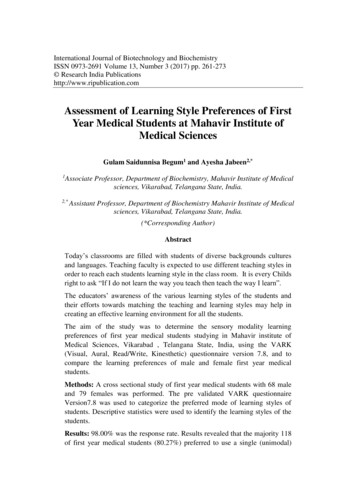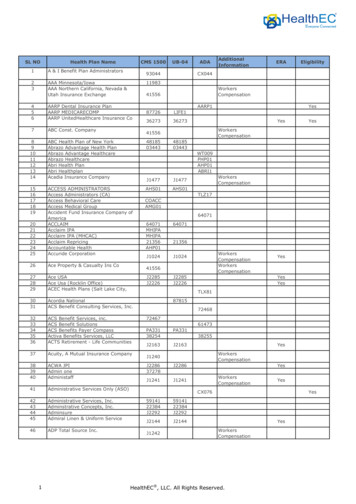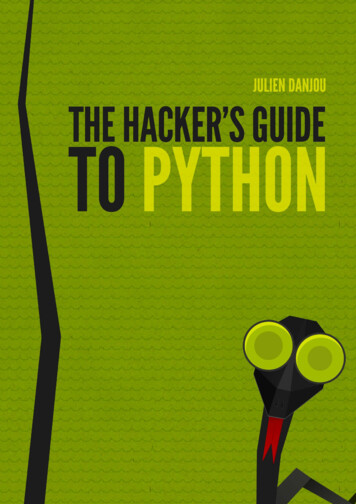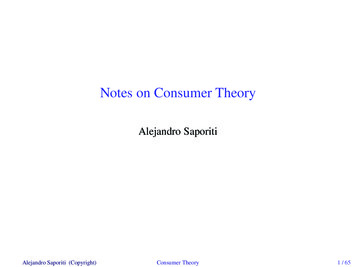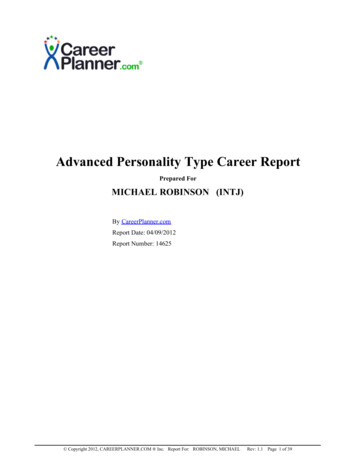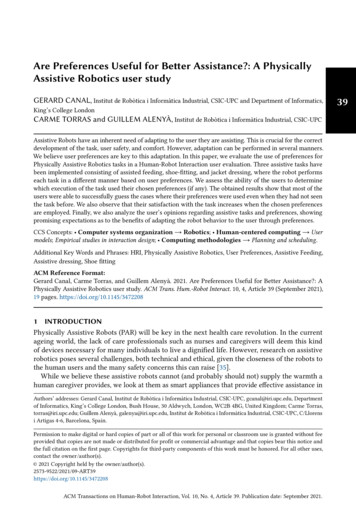
Transcription
Are Preferences Useful for Better Assistance?: A PhysicallyAssistive Robotics user studyGERARD CANAL, Institut de Robòtica i Informàtica Industrial, CSIC-UPC and Department of Informatics,King’s College LondonCARME TORRAS and GUILLEM ALENYÀ, Institut de Robòtica i Informàtica Industrial, CSIC-UPCAssistive Robots have an inherent need of adapting to the user they are assisting. This is crucial for the correctdevelopment of the task, user safety, and comfort. However, adaptation can be performed in several manners.We believe user preferences are key to this adaptation. In this paper, we evaluate the use of preferences forPhysically Assistive Robotics tasks in a Human-Robot Interaction user evaluation. Three assistive tasks havebeen implemented consisting of assisted feeding, shoe-fitting, and jacket dressing, where the robot performseach task in a different manner based on user preferences. We assess the ability of the users to determinewhich execution of the task used their chosen preferences (if any). The obtained results show that most of theusers were able to successfully guess the cases where their preferences were used even when they had not seenthe task before. We also observe that their satisfaction with the task increases when the chosen preferencesare employed. Finally, we also analyze the user’s opinions regarding assistive tasks and preferences, showingpromising expectations as to the benefits of adapting the robot behavior to the user through preferences.CCS Concepts: Computer systems organization Robotics; Human-centered computing Usermodels; Empirical studies in interaction design; Computing methodologies Planning and scheduling.Additional Key Words and Phrases: HRI, Physically Assistive Robotics, User Preferences, Assistive Feeding,Assistive dressing, Shoe fittingACM Reference Format:Gerard Canal, Carme Torras, and Guillem Alenyà. 2021. Are Preferences Useful for Better Assistance?: APhysically Assistive Robotics user study. ACM Trans. Hum.-Robot Interact. 10, 4, Article 39 (September 2021),19 pages. ally Assistive Robots (PAR) will be key in the next health care revolution. In the currentageing world, the lack of care professionals such as nurses and caregivers will deem this kindof devices necessary for many individuals to live a dignified life. However, research on assistiverobotics poses several challenges, both technical and ethical, given the closeness of the robots tothe human users and the many safety concerns this can raise [35].While we believe these assistive robots cannot (and probably should not) supply the warmth ahuman caregiver provides, we look at them as smart appliances that provide effective assistance inAuthors’ addresses: Gerard Canal, Institut de Robòtica i Informàtica Industrial, CSIC-UPC, gcanal@iri.upc.edu, Departmentof Informatics, King’s College London, Bush House, 30 Aldwych, London, WC2B 4BG, United Kingdom; Carme Torras,torras@iri.upc.edu; Guillem Alenyà, galenya@iri.upc.edu, Institut de Robòtica i Informàtica Industrial, CSIC-UPC, C/Llorensi Artigas 4-6, Barcelona, Spain.Permission to make digital or hard copies of part or all of this work for personal or classroom use is granted without feeprovided that copies are not made or distributed for profit or commercial advantage and that copies bear this notice andthe full citation on the first page. Copyrights for third-party components of this work must be honored. For all other uses,contact the owner/author(s). 2021 Copyright held by the .org/10.1145/3472208ACM Transactions on Human-Robot Interaction, Vol. 10, No. 4, Article 39. Publication date: September 2021.39
39:2Gerard Canal, Carme Torras, and Guillem Alenyà(a) Feeding a laying person (Arizona (b) Feeding a sitting person (EK (c) Feeding reduced mobility (BRMedical Training Institute1 )Medical Learning Center2 )Nursing School3 )(d) Feeding laterally (American Red (e) Assisting handover self-feed (f) Assistive feeding when mouthCross4 )(Perspektivy5 )can’t be closed (Perspektivy5 )Fig. 1. Examples of different feeding strategies from Certified Nursing Assistant training videos.a highly autonomous manner. To successfully assist people with different degrees of dependency,robots must perform the tasks as good as human carers would do. Achieving this will not onlyincrease the robot acceptance rates but also empower users by allowing them to perform Activitiesof Daily Living (ADLs) autonomously, allowing the human carer to do tasks with a better addedvalue [1, 12, 23]. However, one of the main elements that humans do when assisting someone is toadapt to their specific needs and preferences. Because no person is identical and each of us has theirown tastes, what may work for a user may be disliked for another one. Thus, an increase in taskvariability implies the need for robot adaptation.A clear example of this can be seen in Figure 1. As can be observed in the pictures, extractedfrom Certified Nursing Assistant (CNA) training videos, there are many different ways of doing asimple task such as feeding a person. The strategy will depend on the condition and capabilities ofthe users, but their preferences will also determine the strategy and play an important role in thesuccess of the task.In previous works, we have defined a personalization framework and also the potential preferences that can be considered in Physically Assistive Robotics tasks [6, 7], and we studied how tointegrate such preferences autonomously using AI Planners [8].In this paper, we will use our previous work to evaluate if users can identify executions of theassistive tasks in which the robot was using their chosen preferences, without seeing previousexamples of the task. Therefore, we will use the notion of preferences for assistive robotics asdescribed in [7], where we defined a hierarchical taxonomy of preferences for guiding robot actionselection as well as tuning execution to best meet the user needs and maximize their comfort.1 Extractedfrom: youtu.be/aCIKmu4jIWgfrom: youtu.be/E1vd1O-LgWI3 Extracted from: youtu.be/j D8g2ngVWs4 Extracted from: youtu.be/XvMX76BvAoM5 Extracted from: youtu.be/m4o5u7x4qys2 ExtractedACM Transactions on Human-Robot Interaction, Vol. 10, No. 4, Article 39. Publication date: September 2021.
Are Preferences Useful for Better Assistance?: A Physically Assistive Robotics user study39:3Details on the preferences used in the current work will be provided in Section 3.2, consistingof both task-related preferences guiding action selection and task-independent ones for tuningthe robot velocity and communication verbosity. We also consider whether the tasks fulfilling theuser’s preferences are found more pleasant and whether the able users see potential benefits fordependent users. Finally, the Almere model [22] has been used to evaluate robot acceptance. Forthis purpose, three typical assistive tasks have been considered: assisted feeding, shoe-fitting, andjacket dressing. These tasks can support the autonomy of potential (dependent) users by allowingthem to perform the tasks by themselves, without the help of a human carer. Two robot arms havebeen used to assist the users in performing the tasks in a fully autonomous manner. The users haveexperienced each task two times, answering a questionnaire of their experience after each task.The following sections will detail the used experimental methodology, evaluation measures, andexperiment results.2RELATED WORKPhysically Assistive Robots require a proper interaction with the assisted user to complete the tasksuccessfully. Given the importance of such kind of applications, many works intend to solve someor part of the assistive tasks. Silva et al. [32] propose a modular robotic arm for assisted feeding.Vila et al. [38] assume that impacts may occur accidentally and analyze impact forces and safetymeasures for robot-assisted feeding. A taxonomy of manipulation strategies for feeding is presentedby Bhattacharjee et al. [3]. To do so, they created a dataset of food manipulation. Following up,bite acquisition is further studied by Gallenberger et al. [19], where adaptive strategies select themanipulation primitive to use with each food item. A user study with 25 participants was performedin which users had to determine how easy was to bite off the fork when the robot presented thefood.Yamazaki et al. [40] describe bottom dressing assistance by a robot, where it pulls the clothingalong the user’s legs. The authors integrate visual failure detection and a success study is performedwith different clothing types. A quantitative analysis of dressing dynamics is performed by Chanceet al. [11], where they analyze combinations of user pose, clothing types, and different sensors fordetecting errors such as cloth snagging. A hospital gown is dressed by Erickson et al. [18], wherea deep recurrent model is used to predict the garment forces applied to the user. This is furtherapplied for improving the robot’s control, using only haptic and kinematic data from the robot’send-effector. Zhang et al. [42] propose a tracking method based on Bayesian Networks in latentspaces to fuse robot pose and force for camera-less estimation of user postures while dressing. Theyapplied it to the dressing of a sleeveless jacket. The system is evaluated with able-bodied users whohad some of the movements restricted by braces to simulate user limitations. These works showthat physically assistive robots have received increasing interest from the research community.Still, while some of them focus on adaptivity to the user, none has yet performed a user evaluationon the perception of behavior adaptation through different assistive tasks.Most of these works focus on the independent living of the users by providing them with moreautonomy. Lee and Riek [27] define autonomy as how much users such as older adults feel incontrol over their lives. They argue that to support these users’ autonomy, they should have enoughcontrol over the robots. Moreover, Chien et al. [14] show that providing elements of personalrelevance such as customized designs and settings, as well as positive experiences, can improve theacceptance and use of assistive robots by older adults. Therefore, the customization of the robot bymeans of preferences may have a great impact on the autonomy that Physically Assistive Robotsprovide. Preferences may be used to grant more control to the user over how the robot behaves aswell as more options for customization and personalization. Other authors have also focused on theneed for personalization and adaptation to improve user assistance. For instance, Klee et al. [26]ACM Transactions on Human-Robot Interaction, Vol. 10, No. 4, Article 39. Publication date: September 2021.
39:4Gerard Canal, Carme Torras, and Guillem Alenyàprovide personalized assistance for hat dressing in a turn-taking manner. To do so, constraints aregenerated and learned based on human behavior in response to the robot’s repositioning requests.User modeling is used by Gao, Chang, and Demiris [41] to personalize dressing assistance to userswith limitations. The user’s movement space is modeled to obtain regions with different reachingcapabilities. This space is then used to plan the robot motions when dressing a sleeveless jacket.This approach is basically reactive and the adaptation does not take into account user preferences.Kapusta et al. [24] present a task optimization of robot-assisted dressing, TOORAD, where a plan isgenerated for both the person and the robot, by using a simulation model including geometry andkinematics of the human, the robot, and the environment. This helps to provide personalized plansfor users. A study with six participants with physical disabilities, with the system successfullyassisting four of them. The authors state the need for variations on the forms of assistance, whichwe try to assess in this paper.Moreover, personalization and user preferences in HRI has also been widely acknowledged ina broader range of topics. Tapus et al. [34] developed a Socially Assistive Robot (SAR) to assist,encourage and interact with post-stroke patients in rehabilitation. The personality of the robotis modified to match the user’s one, modifying elements such as the levels of extroversion andintroversion. They also modify robot proxemics and speed and vocal content, similarly to someof our proposed preferences. The authors demonstrate that users prefer the robot that has anadapted behavior to match their personality, leading to improved task performance. Moro et al.[29] propose a behavior personalization method for SAR consisting of the combination of Learningfrom Demonstration and Reinforcement Learning (RL). In it, the caregivers demonstrate differentbehaviors for the robot, which are used to learn general behaviors. Then, RL is used to obtain apolicy that selects the most appropriate behavior given the user’s cognitive level. Preferences forhand-overs are analyzed by Cakmak et al. [5], where robot and object configurations are adaptedto the user preferences that relate to the position and orientation of the object. Lee et al. [28]carried out a long-term field experiment with a snack delivery robot. Participants interacted withthe robot over two months and the robot adapted their social interactions. The robot was ableto remember the user’s favorite snacks, usage patterns, and robot behaviors. Results showed anincrease in rapport with the robot and the users and increased participants’ cooperation. Learningof user preferences based on ratings is performed in [2], where preferences are learned from userratings over time. Three models of users are defined, which integrate preference profiles. Theyshow its applicability in preferences over light animations in a mobile robot. Chevalier et al. [13]designed a personalized HRI environment for individuals with autism spectrum disorder. The user’spersonality (introversion and extroversion) is used to create a model that predicts user preferencesby Cruz-Maya and Tapus [15]. The user evaluation performed shows that the behaviors generatedby the model were more preferred by the users. Preferences for social interaction parameters suchas distance and speeds are evaluated by Rossi et al. [31], where comfortable stopping distance isevaluated against human pose and user personality. The authors state the importance of learningthe preferences in order to adapt the robot behavior, which would foster acceptance by the usersand safety feelings. User preferences for robot motion planning are learned by Wilde et al. [39]. Userpath ranking is used to learn user constraints regarding the task. Similarly, Hayes et al. [21] learnuser preferences over continued interaction to improve navigation tasks. Preferences for servicerobots are studied by Torres et al. [36], where a preference reasoning is proposed. Preferences overservice robotics scenarios such as object placement and user tastes are used to interact with theuser.In addition to all this, assistive robots have the problem of acceptance. Society is still reluctant toaccept social robots for domestic purposes, as analyzed by de Graaf et al. [16]. The authors statethat it is vital to include the opinion of future users in order to adapt the robots to their preferences.ACM Transactions on Human-Robot Interaction, Vol. 10, No. 4, Article 39. Publication date: September 2021.
Are Preferences Useful for Better Assistance?: A Physically Assistive Robotics user study39:5A long-term acceptance study with older adults was performed by Piasek and Wieczorowska-Tobis[30], where high acceptance was demonstrated by users in need of social assistance, with thisuser segment being open to facilitating technologies. Another study in the same direction wasperformed by Smarr et al. [33]. In it, twenty-one older adults completed questionnaires regardingtheir preferences and openness to assistive robotics. The results show a preference for instrumentaltasks such as housekeeping or medication reminders but were less open to receiving assistance intasks such as shaving or hairdressing. A similar analysis is performed by Deutsch et al. [17], wherea qualitative study with thirty cognitively-able individuals. Results show many opportunities forhome robots, and some user needs that feel threatened by the inclusion of such devices. However,the current generation shift may lead to inconclusive results when experimenting with currentolder adults. To this end, Gessl et al. [20] study the perceptions and acceptance of future olderadults. The study spans 188 users from 20 to 60 years of age, where they found correlations betweenage, gender, and personality with technology acceptance. The authors state that personality playsa significant role in the acceptance of assistive robotics technologies. Although there may notbe a clear link between users’ personality and their preferences, we believe this strengthens theneed for personalized and preference-based robotic behaviors, given that robot acceptance maybe increased if they can adapt their behavior to match the user needs. Other similar studies, likethe one by Biswas et al. [4], try to assess whether older adults are different from young userswhen interacting with robots, in order to understand how communication preferences changeby age. Results show the older people’s preferences in speech over a tablet were more similarto those aged under 21 than the ones in the middle group aged from 22 to 64. Recently, a modelto measure Robot Acceptance (the RAM-care model) [37] was proposed based on a survey ofhealthcare professionals with firsthand experience with the use of robots. The model builds onsome technology acceptance models integrating interpersonal values, moral and instrumental onesas notable factors to account for robot acceptance in care settings. It also shows that personalvalues affect the perceived usefulness of the robots, which would be related to user preferences.Although many important works have focused on the use of preferences, we are not aware ofany of them analyzing whether users can assess the use of their own preferences, which is whatwe study in this paper. We believe this is a key factor to improve user acceptance and increase theoverall interaction and assistance.3 METHODOLOGYWhile it may seem apparent that preferences and adaptation can improve a Physically AssistiveRobotics task, there are not many experiments proving so. However, the design of a system able tomodify its behavior based on user preferences does not imply such a system will be adaptive andcompliant with the preferences as the user would expect, as this is a subjective measure of the user.And, although the user may be able to distinguish the behaviors while comparing them, this wouldnot usually be the desired case for assistive robotics at homes. In that case, the system should bemore plug-and-play and managed by non-technical users, without the need of knowing how arethe different preferences translated to actual robot behaviors.Therefore, the main purpose of this study is to determine whether a user can identify when therobot’s behavior is guided by his/her own selection of preferences, given our system and setup. Wealso want to know if the preferences give a feeling of better assistance. Finally, we want to find outif the behaviors produced by different preferences are observed as different by the users, to see notonly whether the user can perceive when their preferences are used, but also when they’re not andthe different behavior is observed.Accordingly, the input parameters will be the chosen preferences by the user. These will be fedinto a task planner that will choose the different actions to be executed based on the preferencesACM Transactions on Human-Robot Interaction, Vol. 10, No. 4, Article 39. Publication date: September 2021.
39:6Gerard Canal, Carme Torras, and Guillem Alenyàprovided. The task planner uses methods similar to the ones presented in [8]. With this approach,the planner is free to choose any of the available actions to complete the task, but there is anassociated penalization on each action that doesn’t satisfy the user preferences. Therefore, it may bepossible that the planner selects actions that do not comply with the preferences in some situations.Our task planning system comprised the ROSPlan framework [10] with the RDDL extension [9]and the PROST planner [25].The following subsections will detail the hypotheses, setup, scenarios, instruments, and experimental methodology.3.1HypothesesWe have devised three hypotheses to assess the impact and usefulness of the use of preferences tomodify the robot behavior in assistive tasks.H1: the preferences modify the behavior of the robot in an expectable way.H2: the interaction with the robot is more pleasant when preferences are used.H3: different preferences will produce clearly different robot behaviors identifiable by the user(regardless of their beliefs about the use of their preferences).H1 will allow us to assess whether the users can determine when their preferences are used. H2will evaluate if the preferences produce more pleasant behaviors. Finally, H3 is meant to confirmthat the preferences do produce different robot behaviors. This is considered independently of thepreference’s ability to produce apparent behaviors, which is covered by H1.3.2ScenariosWe have selected three Physically Assistive Robotics tasks to be carried out by the participants. Inwhat follows, we detail the tasks that have been used to evaluate the use of the preferences alongwith a description of the preference values that the user could choose per each task. Examples ofthe setups for the different tasks are shown in Figure 2. Assistive feeding: The robot feeds the user one spoonful. The spoon is empty for the experiments. The task-related preference is the proximity, which states whether the user wantsthe robot to be close, far, or at intermediate distance. This is used by the planner to decidewhether to use an action that inserts the spoon in the user’s mouth, or another one that letsthe user get the food while the robot waits. Shoe fitting: The robot approaches a shoe to the user, who prepares the foot in front of it, andthe shoe is fitted. Then, the robot releases the shoe and the task is finished. The preference tobe chosen relates to the movement of the right foot, which could be either nothing, a bit, or alot/normal movement. Users were allowed to freely simulate an ankle injury that prevented(a) Assistive feeding setup.(b) Shoe fitting setup.(c) Sleeved garment dressing setup.Fig. 2. Setup used for the experiments in the three tasks.ACM Transactions on Human-Robot Interaction, Vol. 10, No. 4, Article 39. Publication date: September 2021.
Are Preferences Useful for Better Assistance?: A Physically Assistive Robotics user study39:7them to move the foot. The robot behavior changed in the way the shoe was fitted, and inthe amount of force that was applied against the foot. Jacket (open sleeved garment) dressing: The robot has the garment grasped with two arms,and it dresses the user. Possible behaviors are starting with one arm or the other, or insertingboth together. This could be done in each part of the task, be it the sleeve insertion, lower armdragging, or upper-arm dressing. In this task, the user could choose how much the right armcould be moved, again simulating injury if desired. The possible values were no movement, abit, or normal movement. This preference guided the behavior of the robot by starting forthe right arm or using actions that would not affect the arm movement, either by forcing theuser to move or by stretching the arm with the garment.These tasks are widely addressed by the PAR community, given that they have a potentially highimpact on the dependent users’ lives. They represent some of the most basic needs without whicha human cannot live with dignity. The selected tasks are still safe enough to prevent user harmwhen performed by a robot.Given that we are mainly focused on the behavior changes observed by the users, we havesafely implemented the tasks by compromising some elements in favor of safety. Therefore, wehave implemented fixed trajectories learned kinesthetically in joint space to prevent any potentialmisbehavior or unexpected movement of the robot due to sensor faults, misdetections, or potentialsingularities in the inverse kinematics that could harm the user.We believe that, although this may hinder a bit the experience of the users, it does not impedethem the assessment of the behavior of the robot neither the ability to discern the cases in whichthe preferences are being used. This does not prevent them to be able to participate in the task andexperience the assistance first-hand in a safe environment.Apart from the task-related preferences, the user could choose two additional preferences foreach task (but with the possibility of providing different values per each task). We decided to usethe same two preferences to simplify the user’s task. These preferences are: Robot speed: defines the speed at which the robot moves, using fuzzy terms. The options wereslow, intermediate, or fast. No demonstration of the speeds was performed beforehand, so itwas based only on user intuition. The planner selected the speed based on the preferencesand the reward function specified in the planning domain. The speed was selected by theplanner as a parameter of the movement actions. Robot verbosity: specifies whether the robot should speak or not. In our scenarios, speakingrelates to informing the user before each task was being performed. An example of speechis: “I am approaching your right hand”. Possible values for the preference are sometimes,always, or never. As this is a preference and not a constraint, the robot may decide to speakeven in cases when the preference was not to speak. For instance, it may speak to inform theusers that it will not insert the food into their mouth but instead wait for them to get thefood while the robot stays still. For the planner, speaking was an extra action that could beexecuted before a movement action, based on the preferences and the reward function. Theaction was not needed to complete the task, but the execution of the speaking action whenthe preferences specified it produced more reward for the planner.The tasks have been implemented in the robot and behaviors have been designed for each ofthem. The decision making is performed using task planning, and the preferences are used in thesame way as described in [8]. During the tasks, the robot was acting in a fully autonomous waywithout external interventions.ACM Transactions on Human-Robot Interaction, Vol. 10, No. 4, Article 39. Publication date: September 2021.
39:83.3Gerard Canal, Carme Torras, and Guillem AlenyàMaterialThe experiments were carried out using two 7 degrees-of-freedom Barrett WAM robotic arms. Thefeeding and shoe fitting tasks were using only one arm, while the jacket dressing task employedboth of them. The robots prepared to execute each task can be seen in Figure 2. The robot behaviorwas based on pre-learned trajectories before the experiments began. Each task was split up indifferent actions (such as “approach to foot” or “insert spoon”), and each action was executed by oneor more trajectories (i.e., different approaching movements). The learned trajectories were definedas the standard speed movements, and they were slowed down and speeded up to generate thetrajectories for the fast and slow velocities. When executing the tasks, the robot was reproducingthe prerecorded trajectories according to the actions chosen by the task planner (action, specifictrajectory, and speed). The reward function driving the planner action selection was based on a setof rules that link the actions with the preferences, generating reward when the preferences arefulfilled. As an example, when speed was high, the robot would try to not approach frontally (aswe perceived this as being more threatening). For the same reason, this approach strategy wasalso discouraged (given a negative reward) if the proximity was set to be high. The speed bandswere explicitly narrower for the feeding trajectory due to the inherent danger of the task. All themovement actions were executed using compliant controllers that allow for perturbances in therobot movement, as well as stopping on collision.Additionally, each user was given a single-use spoon for the feeding task. This task also neededa table, a plate, and a chair. No food was supplied to the users, both for health and safety reasons.The shoe-fitting task required a shoe, which was chosen to be a Crocs -like shoe, and a stool to sitthe person in. Finally, the jacket dressing task was using a big size sleeved shirt that would fit allthe users and was wide enough to prevent harm by the garment getting stuck while fitting.3.4ParticipantsThirty participants volunteered to take part in the experiments. The recruitment process wasperformed through posters and email announcements in departmental mailing lists of the university.The participants ranged from students, researchers, administrative staff, and some relatives ofmembers of the university community. Most of the participants were familiar with technology.All of the participants in the study were healthy, cognitively-aware, and able-bodied adults. Eventhough those users are no the target population for our applications, we believe the state of thePhysically Assistive Robotics systems are not mature enough to be used with potential end-users.We needed some part of flexibility from the user as well as full cognitive capacities to understandthe task, the test, and what was their role in the experiment, which was to focus on the robot’sbehavior and see whether there were changes and their preferences were u
(d) Feeding laterally (American Red Cross4) (e) Assisting handover self-feed (Perspektivy5) (f) Assistive feeding when mouth can’t be closed (Perspektivy5) Fig. 1. Examples of different feeding strategies from Certified Nursing Assistant training videos. a highly autonomous manner. To




